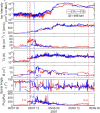The Need for Near-Earth Multi-Spacecraft Heliospheric Measurements and an Explorer Mission to Investigate Interplanetary Structures and Transients in the Near-Earth Heliosphere
- PMID: 39308932
- PMCID: PMC11415466
- DOI: 10.1007/s11214-024-01108-8
The Need for Near-Earth Multi-Spacecraft Heliospheric Measurements and an Explorer Mission to Investigate Interplanetary Structures and Transients in the Near-Earth Heliosphere
Abstract
Based on decades of single-spacecraft measurements near 1 au as well as data from heliospheric and planetary missions, multi-spacecraft simultaneous measurements in the inner heliosphere on separations of 0.05-0.2 au are required to close existing gaps in our knowledge of solar wind structures, transients, and energetic particles, especially coronal mass ejections (CMEs), stream interaction regions (SIRs), high speed solar wind streams (HSS), and energetic storm particle (ESP) events. The Mission to Investigate Interplanetary Structures and Transients (MIIST) is a concept for a small multi-spacecraft mission to explore the near-Earth heliosphere on these critical scales. It is designed to advance two goals: (a) to determine the spatiotemporal variations and the variability of solar wind structures, transients, and energetic particle fluxes in near-Earth interplanetary (IP) space, and (b) to advance our fundamental knowledge necessary to improve space weather forecasting from in situ data. We present the scientific rationale for this proposed mission, the science requirements, payload, implementation, and concept of mission operation that address a key gap in our knowledge of IP structures and transients within the cost, launch, and schedule limitations of the NASA Heliophysics Small Explorers program.
Keywords: Coronal mass ejection; Interplanetary space; Mission concept.
© The Author(s) 2024.
Conflict of interest statement
Competing InterestsThe authors declare no competing interests.
Figures








References
-
- Akhavan-Tafti M, Johnson L, Sood R, Slavin JA, Pulkkinen T, Lepri S, Kilpua E, Fontaine D, Szabo A, Wilson L, Le G, Atilaw TY, Ala-Lahti M, Soni SL, Biesecker D, Jian LK, Lario D (2023) Space weather investigation frontier (SWIFT). Front Astron Space Sci 10:1185603. 10.3389/fspas.2023.1185603
-
- Al-Haddad N, Nieves-Chinchilla T, Möstl C, Hidalgo MA, Marubashi K, Savani MP, Roussev II, Poedts S, Farrugia CJ (2013) Magnetic field configuration models and reconstruction methods for ICMEs: a comparative study. Sol Phys 284:129–149. 10.1007/s11207-013-0244-5
-
- Al-Haddad N, Lugaz N, Poedts S, Farrugia CJ, Nieves-Chinchilla T, Roussev II (2019) Evolution of coronal mass ejection properties in the inner heliosphere: prediction for the Solar Orbiter and Parker Solar Probe. Astrophys J 884(2):179. 10.3847/1538-4357/ab4126
-
- Al-Haddad N, Galvin AB, Lugaz N, Farrugia CJ, Yu W (2022) Investigating the cross sections of coronal mass ejections through the study of nonradial flows with STEREO/PLASTIC. Astrophys J 927(1):68. 10.3847/1538-4357/ac32e1
-
- Ala-Lahti M, Ruohotie J, Good S, Kilpua EKJ, Lugaz N (2020) Spatial coherence of interplanetary coronal mass ejection sheaths at 1 AU. J Geophys Res Space Phys 125(9):2020–028002. 10.1029/2020JA028002
LinkOut - more resources
Full Text Sources
Miscellaneous
